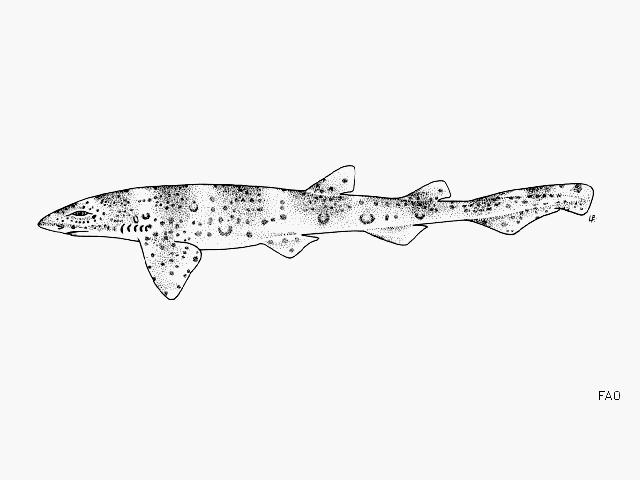Scyliorhinus haeckelii
(Miranda Ribeiro, 1907)
Freckled catshark
Classification: Elasmobranchii Carcharhiniformes Scyliorhinidae
Reference of the original description
Fauna Braziliense. Peixes. II. Desmobranchios. Archivos do Museu Nacional do Rio de Janeiro, 14, 131–217
Fauna Braziliense. Peixes. II. Desmobranchios. Archivos do Museu Nacional do Rio de Janeiro, 14, 131–217
Image of the original description
.jpg)
Scyliorhinus haeckelii (Miranda Ribeiro, 1907)
.jpg)
Scyliorhinus haeckelii (Miranda Ribeiro, 1907)
Synonyms / new combinations and misspellings
Catulus haeckelii, Scyliorhinus besnardi, Scyliorhinus cf. besnardi, Scyliorhinus haeckeli, Scyliorhinus haeckelli, Scyliorhinus retifer besnardi , Scyliorhinus retifer haeckelii
Catulus haeckelii, Scyliorhinus besnardi, Scyliorhinus cf. besnardi, Scyliorhinus haeckeli, Scyliorhinus haeckelli, Scyliorhinus retifer besnardi , Scyliorhinus retifer haeckelii
Types
Scyliorhinus haeckelii
Holotype: MNRJ: 494;
Scyliorhinus besnardi
Holotype: USNM: 204376; Paratype: IO: 81BS (dissected) IO: 82BS USNM: 204377;
Scyliorhinus retifer besnardi
Holotype: USNM: 204376; Paratype: IO: 81BS (dissected) IO: 82BS USNM: 204377;
Scyliorhinus haeckelii
Holotype: MNRJ: 494;
Scyliorhinus besnardi
Holotype: USNM: 204376; Paratype: IO: 81BS (dissected) IO: 82BS USNM: 204377;
Scyliorhinus retifer besnardi
Holotype: USNM: 204376; Paratype: IO: 81BS (dissected) IO: 82BS USNM: 204377;
Description :
Citation: Scyliorhinus haeckelii (Miranda Ribeiro, 1907): In: Database of modern sharks, rays and chimaeras, www.shark-references.com, World Wide Web electronic publication, Version 01/2026
Please send your images of "Scyliorhinus haeckelii" to info@shark-references.com

Scyliorhinus haeckelii (Miranda Ribeiro, 1907), © FAO, www.fish-base.org

Scyliorhinus haeckelii (Miranda Ribeiro, 1907), © FAO, www.fish-base.org
Common names
 Alitán pecoso,
Alitán pecoso,  Lija,
Lija,  Tiburón,
Tiburón,  Roussette taches de son,
Roussette taches de son,  Freckled cat shark,
Freckled cat shark,  Freckled catshark,
Freckled catshark,  Cação-gata,
Cação-gata,  Cação-pinto,
Cação-pinto,  Gata,
Gata,  Pintadinho,
Pintadinho,  Pinto
Pinto
 Alitán pecoso,
Alitán pecoso,  Lija,
Lija,  Tiburón,
Tiburón,  Roussette taches de son,
Roussette taches de son,  Freckled cat shark,
Freckled cat shark,  Freckled catshark,
Freckled catshark,  Cação-gata,
Cação-gata,  Cação-pinto,
Cação-pinto,  Gata,
Gata,  Pintadinho,
Pintadinho,  Pinto
Pinto
Short Description
Diagnosis after Compagno, 1984 [517]: Field Marks : A small, slender, dark-saddled catshark with very small black spots outlining saddles and generally covering dorsal surface, small anterior nasal flaps that do not reach mouth, no nasoral grooves, labial furrows on lower jaw only, second dorsal fin much smaller than first. Diagnostic Features : Head and body relatively deep, slender and narrow; greatest width of head about 2/3 of head length; no nasoral grooves; anterior nasal flaps not expanded and falling just short of mouth. First dorsal origin somewhat behind pelvic insertions; second dorsal origin somewhat anterior to anal insertion; interdorsal space slightly greater than anal base. Denticles small and flat, surface of skin relatively smooth. Colour pattern of 7 or 8 dusky and sometimes obscure saddles, outlined by very small black spots which are also generally scattered over the dorsal surface; no light spots. Size small, adults below 40 cm.
Diagnosis after Compagno, 1984 [517]: Field Marks : A small, slender, dark-saddled catshark with very small black spots outlining saddles and generally covering dorsal surface, small anterior nasal flaps that do not reach mouth, no nasoral grooves, labial furrows on lower jaw only, second dorsal fin much smaller than first. Diagnostic Features : Head and body relatively deep, slender and narrow; greatest width of head about 2/3 of head length; no nasoral grooves; anterior nasal flaps not expanded and falling just short of mouth. First dorsal origin somewhat behind pelvic insertions; second dorsal origin somewhat anterior to anal insertion; interdorsal space slightly greater than anal base. Denticles small and flat, surface of skin relatively smooth. Colour pattern of 7 or 8 dusky and sometimes obscure saddles, outlined by very small black spots which are also generally scattered over the dorsal surface; no light spots. Size small, adults below 40 cm.
Distribution
Western Atlantic: western Venezuela, Suriname, Brazil, and Uruguay. Source: www.gbif.org
Western Atlantic: western Venezuela, Suriname, Brazil, and Uruguay. Source: www.gbif.org
Human uses
fisheries: of no interest
fisheries: of no interest
Habitat
demersal; marine; depth range 37 - 402 m
demersal; marine; depth range 37 - 402 m
Remarks
shark-references Species-ID=6323;
shark-references Species-ID=6323;
Parasites (arranged by Jürgen Pollerspöck)
Cestoda
Nematoda
Cestoda
- Ahamulina catarina Marques, Jensen & Caira, 2012 [16472] [19536] [25154]
- Dasyrhynchus pacificus Robinson, 1965 [5977] [16112] [25154]
Nematoda

















